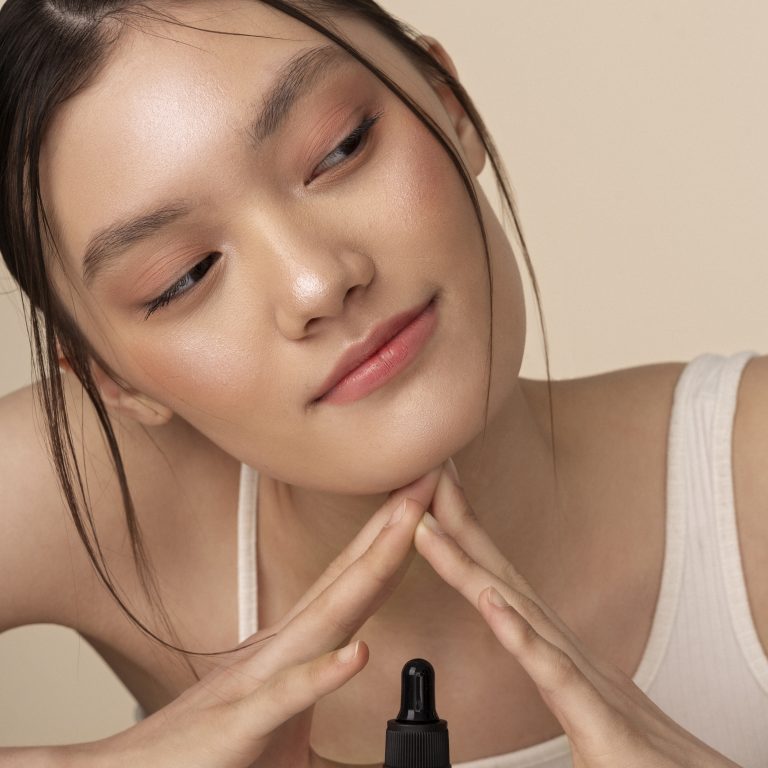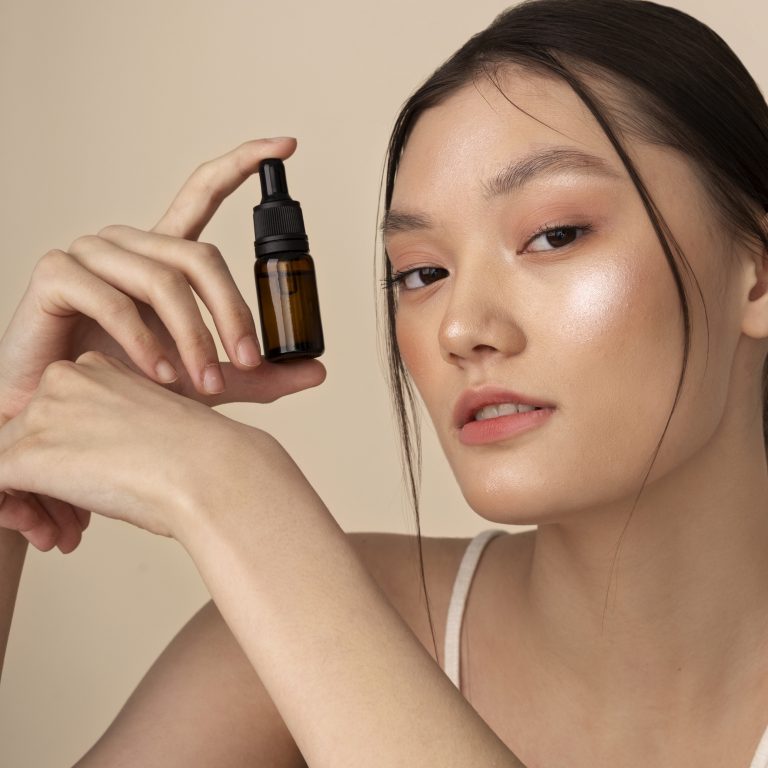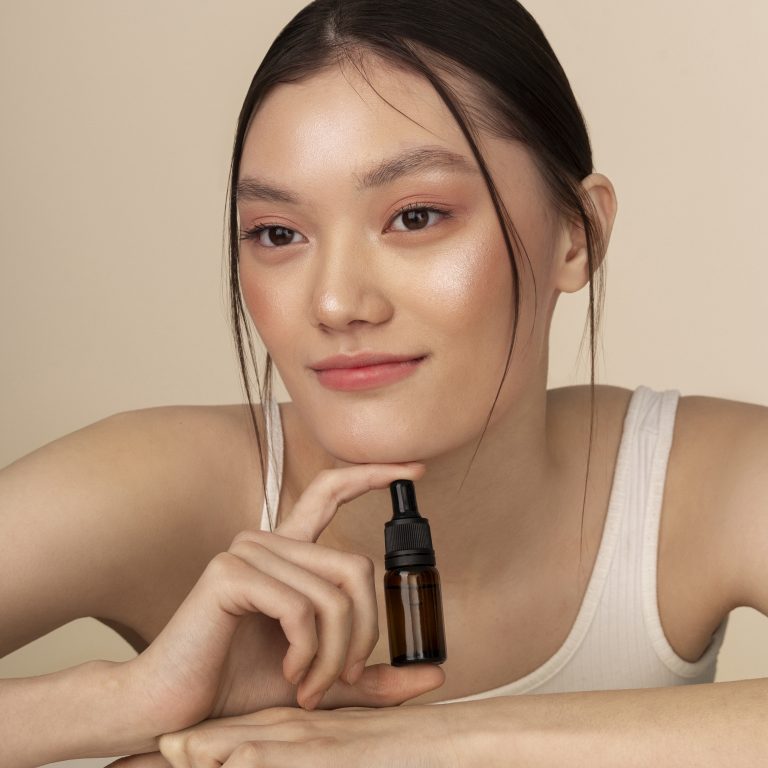
Dermaklair
Your Professional Skincare System

Your Professional Skincare System

There are five main skin types:
2. Dry Skin – Lacks moisture, feels tight, rough, or flaky, and may appear dull.
3. Combination Skin – Oily in the T-zone (forehead, nose, chin) but normal or dry on the cheeks.
4. Normal Skin – Well-balanced, neither too oily nor too dry, with small pores and few blemishes.
5. Sensitive Skin – Easily irritated by products, weather, or certain ingredients, often leading to redness, itching, or burning.
The difference between skin type and skin problem is:
• Skin Type is your skin’s natural condition based on genetics and oil production. It remains relatively consistent over time (though it can change due to age, hormones, or lifestyle). The main skin types are oily, dry, combination, normal, and sensitive.
• Skin Problems are temporary or persistent conditions that can occur regardless of your skin type. These include acne, hyperpigmentation, rosacea, eczema, fine lines, and dehydration. Skin problems can be influenced by factors like diet, environment, skincare products, and health conditions.
For example:
A person with oily skin may have acne (a skin problem) due to excess oil clogging pores.
A person with dry skin may experience eczema (a skin problem) due to a weakened skin barrier.
Choosing the correct skincare depends on your skin type and specific concerns. Here’s a simple guide to help you find the right products:
1. Identify Your Skin Type
Oily Skin: Look for oil-free, lightweight, and mattifying products.
Dry Skin: Choose hydrating, creamy, and nourishing formulas.
Combination Skin: Use a mix of lightweight and hydrating products.
Normal Skin: Stick to a balanced routine with gentle ingredients.
Sensitive Skin: Opt for fragrance-free, soothing, and hypoallergenic products.
2. Follow a Basic Skincare Routine
Morning Routine:
1. Cleanser – Choose a gentle cleanser suited to your skin type.
2. Toner (Optional) – Helps balance the skin. Hydrating for dry skin, clarifying for oily skin.
3. Serum – Target specific concerns (e.g., vitamin C for brightness, niacinamide for oil control).
4. Moisturizer – Hydrate and strengthen your skin barrier.
5. Sunscreen (SPF 30+ daily) – Essential for all skin types to prevent damage.
Night Routine:
1. Cleanser – Double cleanse if wearing makeup or sunscreen.
2. Exfoliator (2–3x per week) – Chemical exfoliants (AHA/BHA) for acne/oily skin, gentle exfoliation for dry skin.
3. Treatment/Serum – Retinol for anti-aging, hyaluronic acid for hydration, etc.
4. Moisturizer/Night Cream – Lock in hydration.
3. Avoid Common Mistakes:
• Don’t over-exfoliate (can cause irritation).
• Patch test new products to prevent reactions.
If you have acne-prone skin, look for these proven ingredients that help reduce breakouts, control oil, and prevent scars:
Active Ingredients for Acne Treatment:
Salicylic Acid (BHA) – Exfoliates inside pores, unclogs them, and reduces blackheads/whiteheads.
Benzoyl Peroxide – Kills acne-causing bacteria, reduces inflammation, and clears breakouts.
Retinoids (Retinol, Adapalene, Tretinoin) – Increases cell turnover, prevents clogged pores, and fades acne scars.
Azelaic Acid – Reduces redness, kills bacteria, and fades post-acne marks.
Oil Control & Soothing Ingredients:
Niacinamide (Vitamin B3) – Controls oil production, minimizes pores, and reduces redness.
Clay (Kaolin, Bentonite) – Absorbs excess oil and detoxifies skin.
Tea Tree Oil – Has antibacterial properties and helps reduce breakouts naturally.
Centella Asiatica (Cica) – Soothes irritation and repairs skin barrier.
Hydration & Barrier Support (Prevents Overdrying):
Hyaluronic Acid – Hydrates skin without clogging pores.
Ceramides – Strengthens the skin barrier and prevents moisture loss.
Green Tea Extract – Anti-inflammatory and reduces oil production.
Ingredients to Avoid (Can Worsen Acne):
Alcohol-based products (drying and irritating).
Coconut oil & heavy oils (can clog pores).
Fragrance & essential oils (can cause irritation).
If you have normal skin, your goal is to maintain balance, keep your skin healthy, and prevent future concerns. The best ingredients for normal skin focus on hydration, protection, and nourishment:
Hydration & Skin Barrier Support:
Hyaluronic Acid – Keeps skin plump and hydrated.
Ceramides – Strengthens the skin barrier and locks in hydration.
Antioxidants for Protection & Glow:
Vitamin C – Brightens skin, evens tone, and protects against sun damage.
Niacinamide (Vitamin B3) – Minimizes pores, reduces redness, and controls oil.
Green Tea Extract – Soothes and protects against environmental damage.
Gentle Exfoliation for Radiance:
Lactic Acid (AHA) – Gently removes dead skin for a smooth texture.
Sun Protection (Essential!):
Zinc Oxide or Titanium Dioxide (Mineral SPF) – Protects skin without irritation.
Chemical Sunscreens (Octinoxate, Avobenzone, etc.) – Lightweight and invisible on skin.


If you’re dealing with pigmentation, dark spots, or uneven skin tone, look for ingredients that brighten the skin, reduce melanin production, and exfoliate gently. Here are the best ingredients to fade pigmentation:
Melanin Inhibitors (Reduce Dark Spots):
Vitamin C (Ascorbic Acid) – A powerful antioxidant that brightens skin and fades pigmentation.
Niacinamide (Vitamin B3) – Reduces dark spots, evens skin tone, and controls oil.
Alpha Arbutin – A gentle ingredient that lightens hyperpigmentation.
Kojic Acid – Inhibits melanin production and helps with stubborn dark spots.
Exfoliating Acids (Boost Cell Turnover):
Glycolic Acid (AHA) – Removes dead skin cells, improves texture, and fades dark spots.
Lactic Acid (AHA) – Mild exfoliation with added hydration benefits.
Mandelic Acid (AHA) – A gentle exfoliant great for sensitive skin with pigmentation.
Skin Renewal & Repair:
Retinol (Vitamin A) – Increases cell turnover, fades spots, and improves skin texture.
Azelaic Acid – Reduces redness, inflammation, and brightens skin.
Sun Protection (Prevents Worsening Pigmentation!):
Sunscreen (SPF 30+ daily) – Essential to prevent UV damage from making dark spots worse.
Zinc Oxide & Titanium Dioxide – Best mineral sunscreen options for pigmentation-prone skin.
A correct skincare routine follows a logical order to maximize effectiveness. Here’s the ideal AM and PM skincare sequence:
Morning Routine (Protection & Hydration):
2. Toner (Optional) – Balances skin and preps for treatments.
3. Serum/essence – Choose based on skin concern (e.g., Vitamin C for brightening, Niacinamide for oil control).
4. Eye Cream (Optional) – Helps with dark circles or puffiness.
5. Moisturizer – Hydrates and locks in moisture.
6. Sunscreen (SPF 30+ Daily) – The most important step to protect from sun damage and aging.
Night Routine (Repair & Treatment):
2. Exfoliator (2-3x per week) – AHA/BHA/PHA to remove dead skin and unclog pores.
3. Serum or Treatment – Retinol for anti-aging, Niacinamide for pores, or Hyaluronic Acid for hydration.
4. Eye Cream (Optional) – Helps with fine lines and hydration.
5. Moisturizer or Night Cream – Nourishes and locks in all previous steps.
6. Face Oil (Optional) – Seals in hydration for dry skin types.
Correct Skincare Layering Guide:
If you are not buying the whole skincare sets, the key to layering skincare correctly is to apply products from thinnest to thickest so that each layer absorbs properly.
If your skincare is irritating your skin, follow these steps to calm irritation and prevent further damage:
Stop Using the Irritating Product Immediately:
• Discontinue the product causing redness, burning, itching, or breakouts.
• Avoid using multiple new products at once—introduce them one at a time to identify the culprit.
Soothe Your Skin:
• Rinse your face with cool water and use a gentle, fragrance-free cleanser.
• Apply a simple, hydrating moisturizer with ingredients like ceramides, aloe vera, or centella asiatica.
• Use cold compresses to reduce redness and inflammation.
Avoid Active Ingredients Until Skin Heals:
• Pause the use of retinol, AHAs, BHAs, vitamin C, benzoyl peroxide, and strong exfoliants.
• Stick to a minimal routine with only a cleanser, moisturizer, and sunscreen.
Use a Gentle Barrier Cream:
• Look for soothing creams with panthenol, ceramides, or colloidal oatmeal to repair the skin barrier.
• Avoid alcohol, fragrances, and essential oils as they can worsen irritation.
Protect Your Skin:
• Always wear sunscreen (SPF 30+) to prevent further sensitivity and damage.
• Avoid direct sun exposure, hot showers, and excessive rubbing of your skin.
Reintroduce Products Slowly:
• After your skin heals (in a few days), reintroduce products one at a time every few days.
• Start with lower concentrations (e.g., start retinol at 0.25% or use exfoliants (only 1-2x per week).
Seek Professional Help if Needed:
• If irritation persists for more than a week, consult a dermatologist.
• For severe reactions (swelling, blisters, extreme redness, or pain), stop all products immediately and seek medical advice.
Yes, Dermaklair offers personalized skincare consultations to help address various skin concerns such as breakouts, scars, pigmentation, aging, and uneven skin tone. To get started, you can contact their team directly:
Phone: +60-11 6119 6194 (Zara)
Address: Dermaklair Malaysia, No 17 Jalan Damai Mewah 2, Taman Damai Mewah, 43000 Kajang, Selangor
For more information about their products and services, visit their official website:
Additionally, Dermaklair provides a Skincare Guide on their website, offering insights into various skin concerns and product usage. This resource can be particularly helpful in understanding how to care for your skin effectively.
Yes, you can use multiple brands in your skincare routine! However, to avoid irritation or ineffective combinations, keep these things in mind:
Check Ingredients – Some active ingredients don’t mix well. For example, retinol and vitamin C can be too harsh together, while benzoyl peroxide and AHAs/BHAs may cause excessive dryness.
Patch Test – Always test new products on a small area of your skin before full application.
Layer Correctly – Apply products in the right order: cleanser → toner → serum → moisturizer → sunscreen (morning) or night cream.
Monitor Skin Reactions – If irritation, redness, or breakouts occur, adjust your routine.
The time it takes to see results from skincare depends on the type of product and your skin concerns. Here’s a general timeline:
• Hydration (Moisturizers, Hyaluronic Acid)
– Immediate to a few days
• Brightening (Vitamin C, Niacinamide)
– 4 to 6 weeks
• Acne Treatments (Benzoyl Peroxide, Salicylic Acid, Retinol)
– 6 to 12 weeks
• Hyperpigmentation, Dark Spots
– 8 to 12 weeks (longer for stubborn marks)
• Anti-Aging (Retinol, Peptides, Collagen Boosting)
– 3 to 6 months for visible improvement
• Sunscreen Benefits
– Prevents damage immediately but takes years to show its full protective effects.
It’s a good idea to stay updated by following their official website, Facebook page, Instagram & Tiktok Dermaklair where they may announce future promotions or special offers. Additionally, consider subscribing to their newsletter, if available, to receive updates directly.
You can purchase Dermaklair products through official website www.dermaklair.com Where we offer a range of medical-grade skincare products formulated by dermatologists and manufactured in Malaysia.
